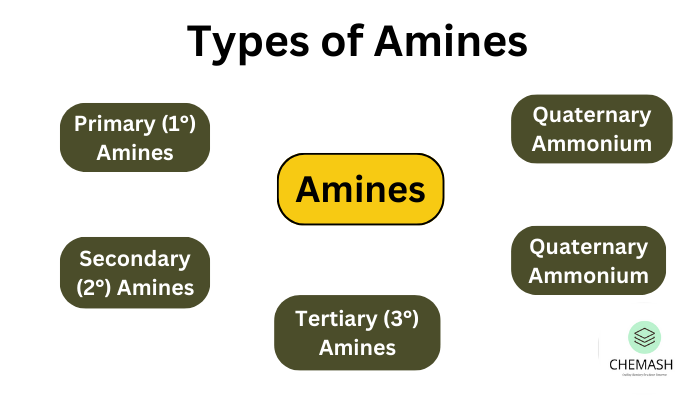Distinction Between 1°, 2°, and 3° Amines – Class 12 Organic Chemistry
In Class 12 Organic Chemistry, amines are an important functional group. They are classified into Primary (1°), Secondary (2°), and Tertiary (3°) amines depending on how many alkyl or aryl groups are attached to the nitrogen atom.
Primary (1°) Amine
Structure: R–NH2
Examples: Methylamine, Aniline
Secondary (2°) Amine
Structure: R–NH–R′
Examples: Dimethylamine, Diphenylamine
Tertiary (3°) Amine
Structure: R–N(R′)–R″
Examples: Trimethylamine, Triphenylamine

Chemical Distinction Tests (Class 12 Exams)
1. Hinsberg Test
Used in Class 12 practical exams to distinguish amines.
- 1° Amine: Soluble sulfonamide in alkali.
- 2° Amine: Insoluble sulfonamide.
- 3° Amine: No reaction.
2. Nitrous Acid Test
- 1° Amine: Evolves N2 gas.
- 2° Amine: Forms N-nitroso compound.
- 3° Amine: No visible reaction.
3. Acylation Reaction
1° & 2° amines form amides with acyl chlorides; 3° amines do not.
Quick Revision Table (Class 12 Chemistry)
| Property | 1° Amine | 2° Amine | 3° Amine |
|---|---|---|---|
| Structure | R–NH2 | R–NH–R′ | R–N(R′)–R″ |
| Hinsberg Test | Soluble | Insoluble | No Reaction |
| Nitrous Acid | Gas Evolution | N-Nitroso | No Reaction |
| Acylation | Yes | Yes | No |
| N–H Bonds | 2 | 1 | 0 |
Practice Questions – Class 12 Chemistry
MCQs
- Which amine reacts with nitrous acid to evolve nitrogen gas?
a) Primary ✅
b) Secondary
c) Tertiary
d) None - Which amine does not undergo acylation?
a) Primary
b) Secondary
c) Tertiary ✅
d) All
True / False
1° amines give soluble sulfonamides in Hinsberg test. True ✅
3° amines evolve nitrogen gas with nitrous acid. False ❌
Fill in the Blanks
Primary amines have ___ N–H bonds. Answer: 2
Tertiary amines have ___ N–H bonds. Answer: 0
FAQs – Class 12 Amines
Q1. Which test is used to distinguish 1°, 2°, and 3° amines in Class 12 practical exams?
Hinsberg test and nitrous acid test are commonly used.
Q2. Why don’t tertiary amines undergo acylation?
They lack an N–H bond, which is necessary for acylation.
